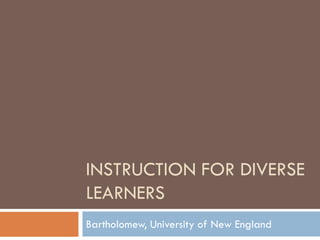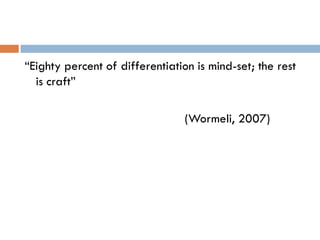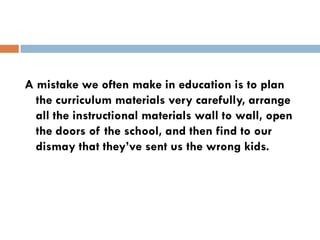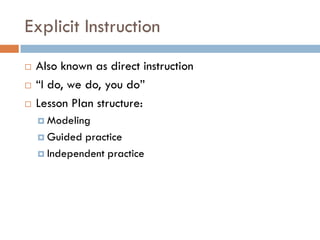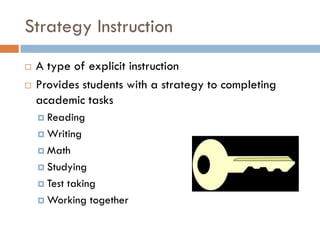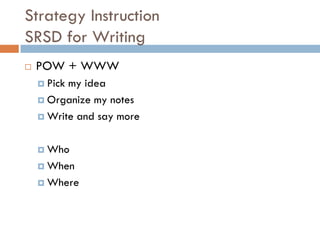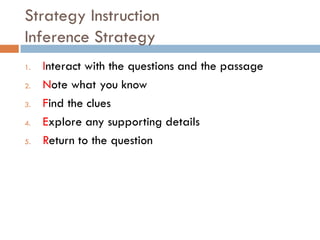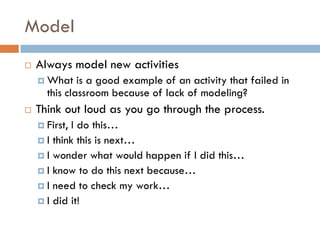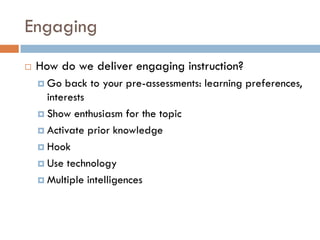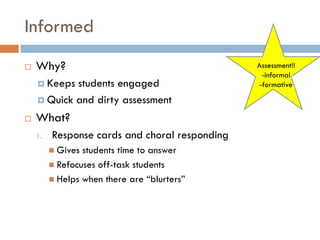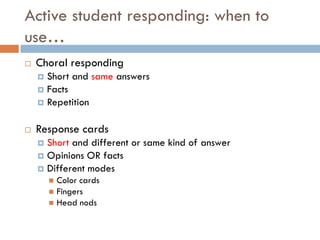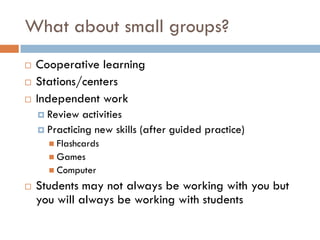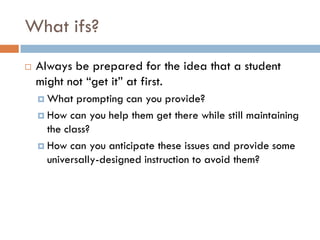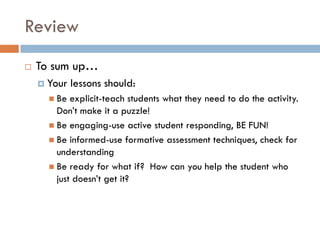Crash course in instruction
- 1. INSTRUCTION FOR DIVERSE LEARNERS Bartholomew, University of New England
- 2. “Eighty percent of differentiation is mind-set; the rest is craft” (Wormeli, 2007)
- 3. A mistake we often make in education is to plan the curriculum materials very carefully, arrange all the instructional materials wall to wall, open the doors of the school, and then find to our dismay that they’ve sent us the wrong kids.
- 4. Characteristics of good instruction How do we get students to achieve the objectives? Explicit Research-based Engaging Informed Ready for the “what ifs”
- 5. Explicit Instruction Also known as direct instruction “I do, we do, you do” Lesson Plan structure: Modeling Guided practice Independent practice
- 6. Strategy Instruction A type of explicit instruction Provides students with a strategy to completing academic tasks Reading Writing Math Studying Test taking Working together
- 7. Strategy Instruction Strategy is typically made up of stages of instruction. Students are taught a strategy to completing tasks Usually has a mnemonic Example: Example: Self-regulated, Strategy Development (SRSD) for writing Set writing goals Students are taught this through a Self-instruct mnemonic Self-monitor Self-reinforce
- 8. Strategy Instruction SRSD for Writing POW + WWW Pickmy idea Organize my notes Write and say more Who When Where
- 9. Strategy Instruction Inference Strategy 1. Interact with the questions and the passage 2. Note what you know 3. Find the clues 4. Explore any supporting details 5. Return to the question
- 10. Model Always model new activities What is a good example of an activity that failed in this classroom because of lack of modeling? Think out loud as you go through the process. First, I do this… I think this is next… I wonder what would happen if I did this… I know to do this next because… I need to check my work… I did it!
- 11. Engaging How do we deliver engaging instruction? Go back to your pre-assessments: learning preferences, interests Show enthusiasm for the topic Activate prior knowledge Hook Use technology Multiple intelligences
- 12. Informed Why? Assessment!! -informal Keeps students engaged -formative Quick and dirty assessment What? 1. Response cards and choral responding Gives students time to answer Refocuses off-task students Helps when there are “blurters”
- 13. Active student responding: when to use… Choral responding Short and same answers Facts Repetition Response cards Short and different or same kind of answer Opinions OR facts Different modes Color cards Fingers Head nods
- 14. What about small groups? Cooperative learning Stations/centers Independent work Review activities Practicing new skills (after guided practice) Flashcards Games Computer Students may not always be working with you but you will always be working with students
- 15. What ifs? Always be prepared for the idea that a student might not “get it” at first. What prompting can you provide? How can you help them get there while still maintaining the class? How can you anticipate these issues and provide some universally-designed instruction to avoid them?
- 16. Review To sum up… Your lessons should: Be explicit-teach students what they need to do the activity. Don’t make it a puzzle! Be engaging-use active student responding, BE FUN! Be informed-use formative assessment techniques, check for understanding Be ready for what if? How can you help the student who just doesn’t get it?
Editor's Notes
- #14: Short and sameShort and differentCHORALChemical formula for water is 2+2 isThe first president of the United states isRESP CARDTell me your favorite bookWhat is one item you recycled this weekend
